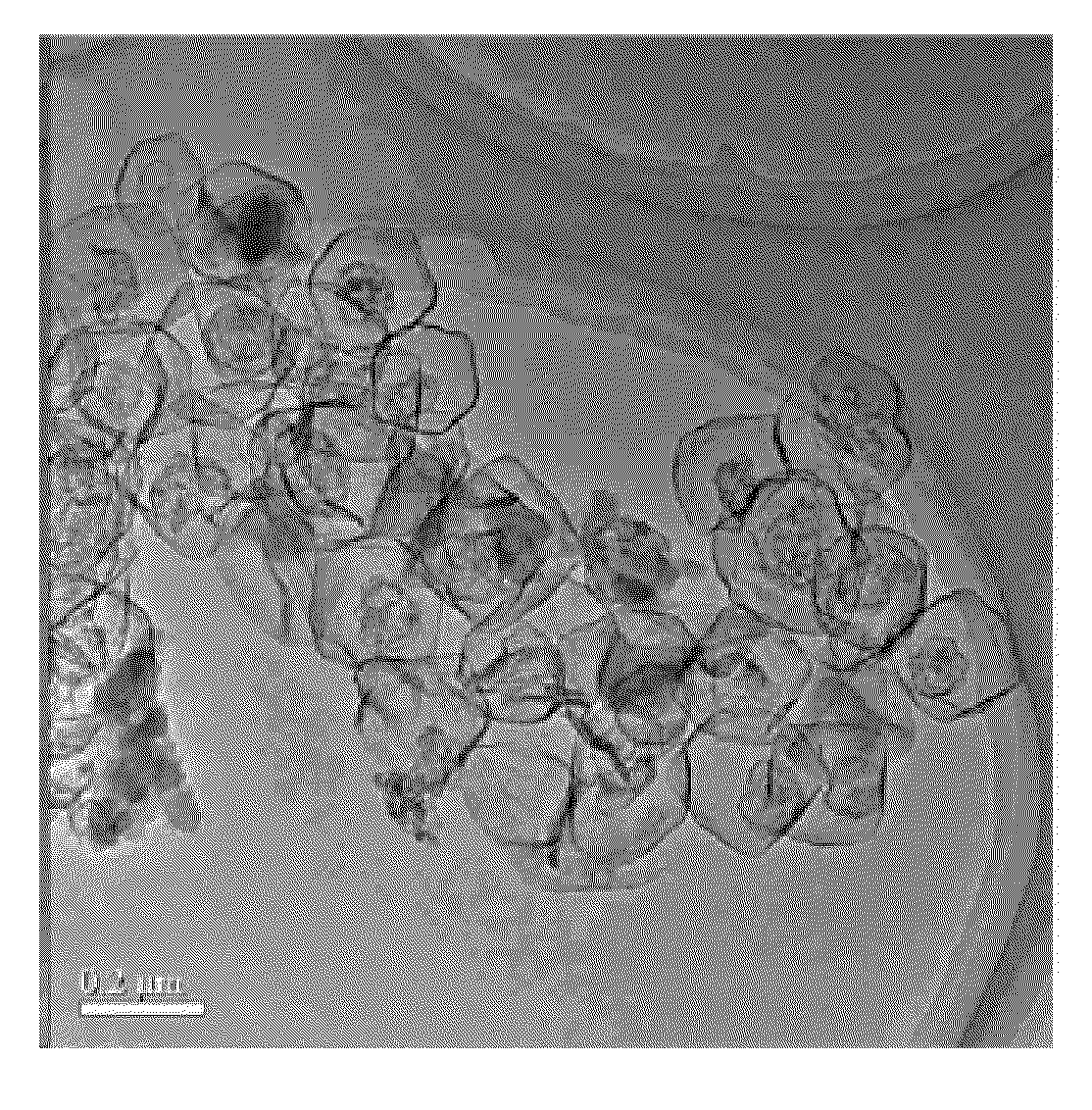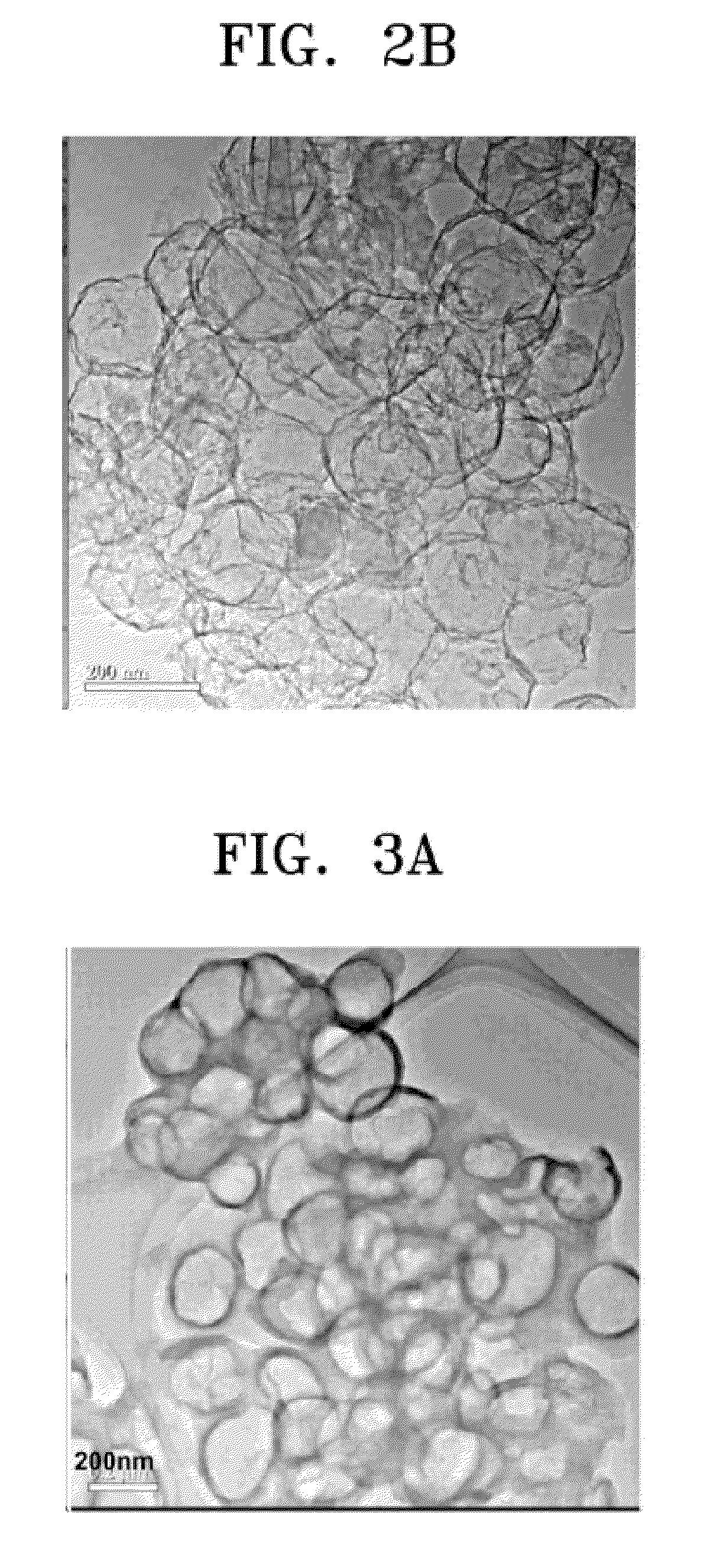Carbon nanosphere with at least one opening, method for preparing the same, carbon nanosphere-impregnated catalyst using the carbon nanosphere, and fuel cell using the catalyst
a carbon nanosphere and at least one opening technology, applied in the direction of cell components, electrochemical generators, physical/chemical process catalysts, etc., can solve the problems of insufficient electrical conductivity of carbon supports, insufficient surface area, and inability to uniformly disperse catalysts on carbon, etc., to achieve higher surface area utilization, lower mass transfer resistance, and electrical conductivity
- Summary
- Abstract
- Description
- Claims
- Application Information
AI Technical Summary
Benefits of technology
Problems solved by technology
Method used
Image
Examples
examples 1-3
[0060]A reaction furnace was purged with a dilution gas at a volumetric flow rate of 500 standard cubic centimeters per minute (sccm) under atmospheric pressure while the temperature of the reaction furnace was elevated to the temperatures listed in Table 1. Copper tartrate (CuC4H4O6.H2O) was used as an organic metal compound and acetylene was used as a hydrocarbon gas to form carbon nanospheres. The flow rate of the dilution gas was 16 L / min and the resulting carbon nanospheres were treated with nitric acid to obtain carbon nanospheres that have at least one opening. The reaction conditions of Examples 1-3 are shown in Table 1.
[0061]
TABLE 1Temperature (° C.)Residence Time (min)RampFlow rate ofPreheatingReactionPreheatingReactionratehydrocarbonDilutionregionfurnaceregionfurnace(° C. / min)gas (ml / min)gasExample 1200450203012.510ArgonExample 2150500302017.530NitrogenExample 310060040302020Nitrogen
[0062]The carbon nanospheres that have at least one opening that were prepared under the c...
examples 4 and 5
[0065]In order to confirm the effects of the reaction conditions on the shape of carbon nanosphere, experiments were preformed by changing the reaction conditions. Copper tartrate (CuC4H4O6.H2O) was used as an organic metal compound and acetylene was used as a hydrocarbon gas. The flow rate of the dilution gas was 16 L / min and the resulting carbon nanospheres were treated with nitric acid. The reaction conditions of Examples 4 and 5 are shown in Table 3.
[0066]
TABLE 3Temperature (° C.)Residence Time (min)RampFlow rate ofPreheatingReactionPreheatingReactionratehydrocarbonDilutionregionfurnaceregionfurnace(° C. / min)gas (ml / min)gasExample 4150700303015.740ArgonExample 5100750403016.325Nitrogen
[0067]The carbon nanospheres with at least one opening that were prepared under the conditions described in Table 3 exhibited the physical properties listed in Table 4.
[0068]
TABLE 4Diameter of carbonWall thicknessnanosphere (nm)(nm)Example 450035Example 560030
[0069]FIG. 3A and FIG. 3B are TEM photo...
example 6
[0072]0.5 g of the carbon nanosphere with at least one opening obtained in Example 1 as a carbon support was placed in a plastic bag, and then 1.9236 g of H2PtCl6 was dissolved in 1.5 mL of acetone in a beaker. The acetone solution was mixed with the carbon carrier in the plastic bag. The mixture was dried in air for 4 hours, and was then transferred to a crucible and dried in a drier at 60° C. overnight. Then, the crucible was placed in an electric furnace under nitrogen flow for 10 minutes. Next, nitrogen gas was replaced with hydrogen gas and the temperature in the electric furnace was raised from room temperature to 200° C. and maintained for 2 hours to reduce a Pt salt that was impregnated on the carbon support. The hydrogen gas was replaced with nitrogen gas and the temperature in the electric furnace was raised to 250° C. at a rate of 5° C. / min and maintained at 250° C. for 5 hours, and then cooled to room temperature. Thus, a carbon nanosphere-supported catalyst with a loadi...
PUM
| Property | Measurement | Unit |
|---|---|---|
| thickness | aaaaa | aaaaa |
| diameter | aaaaa | aaaaa |
| diameter | aaaaa | aaaaa |
Abstract
Description
Claims
Application Information
 Login to View More
Login to View More - R&D
- Intellectual Property
- Life Sciences
- Materials
- Tech Scout
- Unparalleled Data Quality
- Higher Quality Content
- 60% Fewer Hallucinations
Browse by: Latest US Patents, China's latest patents, Technical Efficacy Thesaurus, Application Domain, Technology Topic, Popular Technical Reports.
© 2025 PatSnap. All rights reserved.Legal|Privacy policy|Modern Slavery Act Transparency Statement|Sitemap|About US| Contact US: help@patsnap.com



